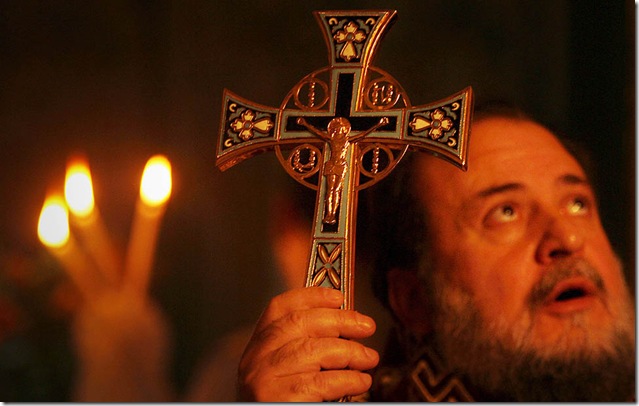There are a host of reasons why Catholics and Protestants convert to one another’s tradition. From the former-Protestant Catholic point of view, it’s often a crisis concerning the function of religious authority (Scripture or Magisterium), the appropriation of salvation (faith alone or a process of sacramental mediation) or a desire for a deeper experience of liturgy. For former-Catholic Protestants (like me) it’s often liberation from injurious forms of guilt, realization of the new birth, or recognition of the sufficiency of Scripture. In addition to these, there is another factor, one that’s seldom discussed. It is a divergent vision of the person of Jesus.
In his book Holy Land USA, Peter Feuerhard, a Catholic journalist, describes what he observed in America’s largest Evangelical theme park. He writes,
I was surrounded by shorts and T-shirts proclaiming The Rock, The Lamb—even one that says Read Between the Lines, with a picture of the back of a crucified Christ, complete with stark red blood stripes. When we enter, the sign for the cafeteria advertises Goliath Burgers and Bedouin beef.[1]
My wife and friends wonder if I have a screw loose. No self-respecting liberal-thinking northeasterner would venture into such a strange world, a place where the worldviews of Disney and Jimmy Swaggart intersect. The 10-year-old daughter of a Catholic friend of mine sees it as sacrilegious to combine the sacred and the profane in a Holy Land amusement park.[2]
I want to pick up on the ten-year-old girl’s comment. Why would the Holy Land Theme Park have Evangelical ten-year-old girls eating Goliath Burgers with sheer delight while their Catholic counterparts are completely offended by the idea? The former regards the sword of the Spirit letter opener and widow’s mite pendant, which she purchased in the gift shop, to be positive contributions to society, or at least to her own life. The later regards such trinkets as religious compromise and wholesale capitulation to popular culture, even if she doesn’t say it in those words.
Toward the end of his book, Feuerhard speaks to the above question when he writes, “Evangelicals are pioneers in bringing American pop culture and baptizing it into the Christian realm.”[3] He might be right. When this cultural baptism is done responsibly, we call it “contextualization,” meaning that we’ve sought to translate biblical truth to our modern context. Catholics and Evangelicals ordinarily agree that this activity is good and necessary. As Paul the Apostle expressed it, “I have become all things to all men so that by all possible means I might save some” (1 Cor 9:22). However, when it’s done poorly we call it something like the trivialization of God, the Evangelical subculture’s shallow side, or cheesy merchandizing. Unfortunately, Evangelicals are famous for leaning in the latter direction.
When you speak with Catholics about popular Evangelical culture you find they have a mixture of amusement, bewilderment, and repulsion. Given the place of tradition, reverence and austerity in Catholic liturgy, it’s not surprising. When sacred value is assigned to tangible items like statues, stained glass, and holy water fonts, the absence of all such concrete symbols naturally leads Catholics to conclude that sacredness is likewise absent. Simply contrast the rich complexity and texture of most Catholic parishes with the minimalist style of Evangelical churches, particularly in some megachurches where you’re unlikely to find even a simple cross, and you can better understand why Evangelical culture leaves many Catholics feeling uncomfortable.
Part of this Catholic critique is influenced by a common Catholic tendency, namely, difficulty appreciating the extent of Jesus’ humanity. Let me explain how this gets worked out. The following story is told of G.K. Chesterton (1874-1936), the eminent British author from a previous generation:
One day the great British writer G.K. Chesterton was barreling down a street in London, preoccupied with weighty thoughts, his thick cape flying behind him. As he turned a corner, head down, he collided with a man rolling a grandfather clock down the narrow sidewalk. Chesterton brushed himself off, scowled at the man, and shouted, “Why can’t you just wear a wristwatch like everyone else?[4]
Chesterton was not only brilliant; he was brilliantly funny. However, while a sharp wit was one of his shining qualities, it’s fascinating to read what he had to say about the humor of Jesus. At the conclusion of his classic book Orthodoxy he writes the following:
There was one thing that was too great for God to show us when He walked upon our earth; and I have sometimes fancied that it was His mirth.[5]
We don’t use the word “mirth” very much today. It describes gladness expressed through hearty laughter. In other words, Chesterton was saying that he couldn’t imagine that the incarnated Jesus would have laughed out loud. The austere God/man walked in real sandals, ate real food, drank real wine, but he never went so far as to utter laughter. Far be it from me to take issue with a literary titan like Chesterton; however, in this instance I must humbly disagree.
I’d like to suggest that Chesterton’s view of Jesus is representative of many Catholics. This is reflected for example in the response of the Catholic girl with her aversion to Goliath Burgers. You’ll recall that she protested the sacrilegious combination of the “sacred” and the “profane.” But where to these categories come from? I’ll grant that Bedouin beef is patently corny, but where do we find the notion that in Christ’s new creation there are two separate spheres called “sacred” and “profane.” We must acknowledge that there is the clear difference between holiness and sin; but to categorically consign experiences like laughter and amusement to the realm of profanity is biblically unwarranted. In fact it’s worse. It leaves you with a Jesus whose feet hover six inches above his sandals but never quite touch down.
If the Catholic flaw is a less than human Christ, many Evangelicals struggle with the other extreme. We conceive of Jesus in running shoes sporting a Sergio Tacchini sweat-suit jogging beside us on the treadmill. Few of us would articulate such a crass perception, but if you listen to Evangelicals refer to God in prayer or conversation, you start to wonder. Divine imminence and personal presence are so drastically emphasized that superficiality reigns instead of the King of Kings and Lord of Lords.
What does all of this have to do with conversion? When we consider one’s movement across the Catholic/Protestant divide, we will usually find the person’s motivation revolving around the question of religious authority and salvation. However, it is simplistic and naïve to believe that one’s decision to convert is made strictly on the basis of doctrinal considerations. We all live in context and community where personal values, priorities, perspectives, and a host of cultural realities factor into the equation. This is precisely what makes conversation at the Catholic and Protestant intersection so interesting and enjoyable: we get to discover and interact with the other’s perspective. And if there is one aspect of a perspective that rises above everything else, it is our view of Jesus. Of all places, this is where conversation with Catholic friends and loves ones ought to focus thoughtful attention.
[1] Peter Feuerherd. Holyland USA: A Catholic Ride Through American’s Evangelical Landscape. New York: The Crossroad Book Company, 2006), p 2.
[2] Ibid., p 151-52.
[3] Ibid., p 160.
[4] Vaughn, Ellen. Time Peace: Living Here and Now with a Timeless God. (Grand Rapids: Zondervan, 2007), p 61.
[5] G. K. Chesterton. Orthodoxy. (San Francisco: Ignatius, 1908), 167-168.





